|
Click artist name to jump to photos and reviews.
INTRODUCTION
Many veteran ceramic artists here are content to rest on their laurels and churn out the same old "clay mix." Others, with Muses urging them on, will not rest on their past triumphs but continue to challenge themselves and their art, for better or worse. If I had the time I would visit exhibitions by such potters every day -- for there are countless potters in Japan who are driven by the Muses. The depth of the ceramic world here is quite amazing, as is the great variety of works that are born from the flames each week. During the month of June (2003), I had the chance to visit Tokyo a few times to take in some exhibitions.
 |
Morino Taimei
First on my exhibition tour was Morino Taimei, an outstanding artist, yet I mean that in the past tense. His work is collected the world over and many pieces have found homes in museums worldwide. Yet, looking at his work, from say 1975, I found the same design pattern at his recent Tokyo exhibition held at the prestigious Takashimaya department store art gallery. Most of his work is engaging, most of the time, but the very stiff atmosphere of the gallery left most of the pieces suffocating.
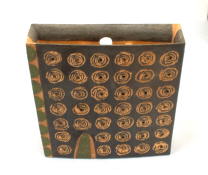 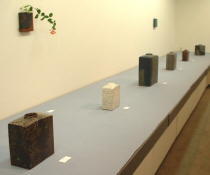
Work by Morino Taimei
His sense of line and color is outstanding, using mostly green, red, white, and metallic tones for his high-shouldered and rounded vessels.
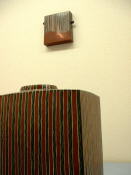 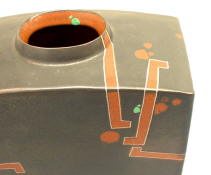
Work by Morino Taimei
Yet for those who have viewed his work before, there was not much new or rewarding. It might do him good to travel again as he did in his youth to find new inspiration. Morino is no doubt one of Japan's finest Kyoto ceramic artists of the 20th century, yet that's all in the past..
Harada Shuroku
Harada has won much praise recently, including the Japan Ceramic Society award, and he is still creating works that have never before been seen within the ancient Bizen tradition.
I went to his exhibition at the Mitsukoshi Department Store Gallery on the third day and was quite surprised to find almost all the works had sold. His fans were so excited about this exhibition that they couldn't wait to take home the smaller pieces. In this case I'm referring to sake cups (guinomi) -- they were all gone! I found some new works by him that had rough surfaces where he applied a clay covering and then some hidasuki (fire-cord markings) -- the effect was fresh and bold.
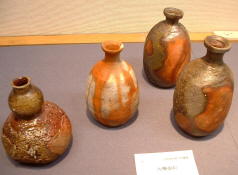
Tokkuri (sake flasks) by Harada Shuroku
So were the larger tsubo (jars) that had large fissures and intentionally added stones in the clay covering. These works were exciting and calming at the same time.
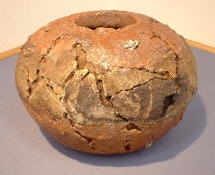 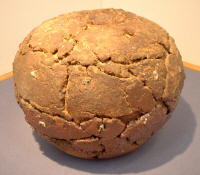
Tsubo (above and below) by Harada Shuroku
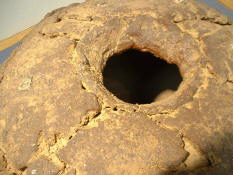
There was a powerful spirit in them that came from this artist and his deep knowledge of the Bizen tradition. Not all the works were like that however. Some of the mizusashi looked a bit awkward, while the stones bursting out of the unique handled bucket felt too contrived (see photos below) -- they worked much better in the tsubo.
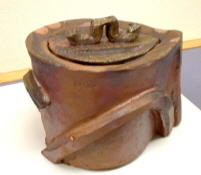 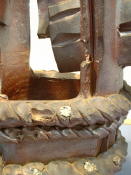
(L) Mizusashi (R) Bucket with Unique Handles
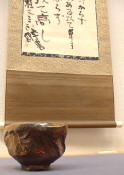 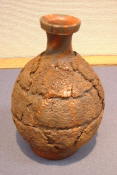
(L) Chawan and (R) Tokkuri by Harada Shuroku
Harada's chawan were very masculine.
His tokkuri were quite traditional in form.
For more on this artist, click here.
Shimura Noriaki
I had meant to visit another Bizen potter's exhibition but arrived a day too late! I was a bit disappointed yet figured what the heck, I'll have a look at the current show. It was the first day and the artist, Shimura Noriaki, was there. I had never met him but after seeing the colorful works I realized he lived not far from me. The exhibition was in the very small second floor gallery at Kuroda Toen (Ginza), and the room was aglow in color and form.
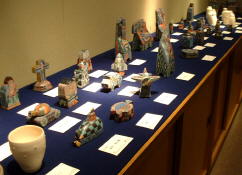
Works by Shimura Noriaki
It felt more like being in a toy store than in a prestigious ceramic gallery. His fascination with robots, jets, monsters, and other non-ceramic themes all found a home in clay.
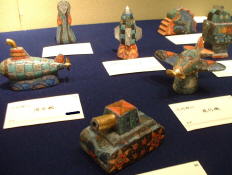
Toy-like works by Shimura Noriaki
Actually, I fell in love with a lot of the work and couldn't help sticking around longer than intended. His work is far different than his teacher's, the late Seto potter Kato Sho. In fact, it's in a class all by itself. Have you ever seen a ceramic tank?

Ceramic Tank by Shimura Noriaki
Not kitsch may I add, like Nakamura Kimpei, but unique in its transformation of common themes into his own ceramic vision. There were nature themes as well, mountains, pineapples and bird kogo, as well as sumo wrestlers and dragons. A great contrast to his work was a smooth creamy glaze he used on various cups that was a delight to hold. I think I'll be paying him a visit this summer, not in Tokyo, but on the Izu peninsula where he lives.
 |
Ancient Masterworks
I always encourage contemporary ceramic collectors to view the ancient masterworks whenever the chance arises. The grand traditions have been flowing for centuries, and any modern potters worth their weight in clay must understand, respect, and continue on in their own way with the spirit of clay and fire.
The finest antique dealers in Japan belong to various associations and clubs, with the most prestigious in Tokyo -- possibly in all of Japan -- being the Tokyo Bijutsu Club (Tokyo Art Club). They hold annual events and the most recent one was in June. Here, one can view and handle some of the finest antique works on the market today. Not all dealers would let me photograph their works but some cordially complied. I was able to see some tremendous tsubo (jars). Many of these were Shigaraki and were being offered for around six million yen or so (about $50,000 each). There were a few outstanding old Karatsu guinomi that I coveted, but the two-million-yen price tag was daunting.
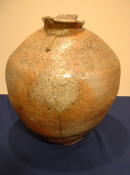  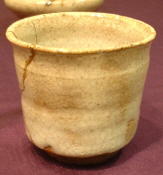
(L) Shigaraki Tsubo (M) Amamori Tsubo (R) Karatsu Guinomi
Other works were from Korea and China. There were even some modern works by Rosanjin, Kaneshige Toyo, Kamoda Shoji and Okabe Mineo. There were also some beautiful Arita, Nabeshima, and Kutani works.
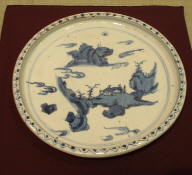
Arita ware
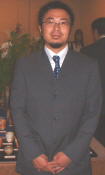 Furutani Kazuya (son of Furutani Michio) Furutani Kazuya (son of Furutani Michio)
The last exhibition I visited was by far the most special for me. It was the Tokyo debut of Kazuya Furutani, the son of Michio Furutani, one of my all-time favorite ceramic artists. Michio regrettably passed away much too soon. It took me more than two hours to reach the gallery, yet I got there just in time for the 10:00 am opening. I made a beeline for the sixth floor gallery. Some people were already in the gallery (I even noticed the famous musician Sojiro), and they were bowing and exchanging greetings and compliments with the young artist.
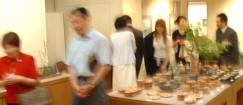
Scene at Kazuya Furutani's exhibition
It was the first time for me to meet this potter, yet I felt there was a connection between us immediately. Looking around the gallery it was easy to see his father's influence, and it was also a pleasure to see that this young man wanted to make his own work. He knows well that he must carry on with his father's style and forms, yet he doesn't want us to blindly compare. He told me how he had to tear down his father's Iga kiln, how he built his own kiln and blended his own clay (he did this to learn for himself), and how his mother didn't want to attend the exhibition for there were too many memories lingering there. His father debuted at this gallery, and held nearly twenty exhibitions over the years at this location.
Kazuya's forms were crisp and well-crafted and showed how much the young Furutani had absorbed by watching his father. Some of the best lessons in a pottery are often silent examples. His guinomi were splendid, his tableware was user-friendly plus had marvelous "color," his tsubo were bold, and his vases were perfect for holding flowers. I was delighted and knew that his father was there in spirit and smiling down for sure upon his only son Kazuya.
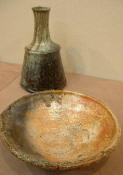 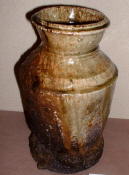 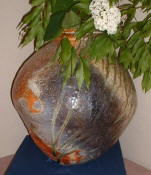
(L) Plate & Vase (M) Ash-crusted vase (R) Tsubo
|